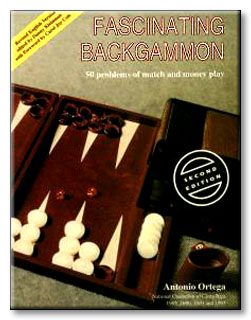| |

|
Fascinating Backgammon
Antonio Ortega, 1992
|
Fascinating Backgammon consists of 50 problems with approximately 100 analyzed positions including all of the variations. The problems cover various aspects of money and match play with emphasis on cube action in the endgame. The author, an experienced international player, has won the Costa Rican National Championship in four of the last five years.
The book is a fine tutorial for advanced beginner and intermediate players and a handy review for the expert. However do not expect to find any trailblazing insights here; most of the concepts and several of the positions have previously appeared in other backgammon publications.
Still, the book has many strengths, such as offering the reader convincing solutions supported by hard data. Many solutions include results from computer rollouts or bearoff programs, and there are exhaustive match-equity calculations to support the recommended cube actions in match play.
Here's a sample problem from the book that arises frequently in actual play:
|
|
|
Position 1.
Blue to play a 5.
|
Position 1 is derived from Problem 29 in the book after Blue has played three forced 5's of a 5-5 roll. With the last 5, Blue can play (a) 5/off or (b) 6/1, leaving 11 shots in either case. The author lists the blot numbers next turn after each play (15 numbers after play (a), 22 numbers after play (b)], concludes that play (a) is safest and best, corroborates the conclusion with results from Hugh Sconyers's CD-ROM backgame program, and then presents the underlying principle:
"... the farther back your home-board blot is, the easier it is to clear next turn. ... With his blot on the 5-point, Blue can play only aces to his highest occupied point, the 4-point, from where he can then play the other number on his dice. But with his blot on the 6-point, Blue can play aces to the 5-point and deuces to the 4-point, then play his other number from whichever of these points to which he has moved his blot. You will notice that 6 of the 7 extra blotting rolls after play (b) include deuces."
With the English edition of the book, edited by Danny Kleinman and reviewed by Neil Kazaross, technical accuracy is very high. I found only one significant error:
|
|
|
Position 2.
Blue on roll.
Cube action?
|
Position 2, which is Problem 18 in the book, is borrowed from a Leading Edge Backgammon article [Feb. 1991, p. 6]. The book states that in a money game or at the start of a long match, the correct cube action is double/pass. In fact, the position is a clear take as is stated in the cited article.
The production quality of the book is excellent. The text and board diagrams are easy to read and the binding construction should last for many years. There are even some lighthearted moments such as the following passage from the introduction:
"The ACB's [Costa Rican Backgammon Association's] efforts to recruit new players have produced a few surprises. Once, responding to an advertisement in a local newspaper for a novice tournament, a new player called to congratulate us on organizing the exciting tournaments he'd been attending. He asked us to sign him up, and then inquired if he should bring his on raquet to the tournament, or if the ACB would supply one."
In summary, I recommend Fascinating Backgammon as a worthwhile purchase or holiday gift for any player from advanced beginner to expert.



![]()
